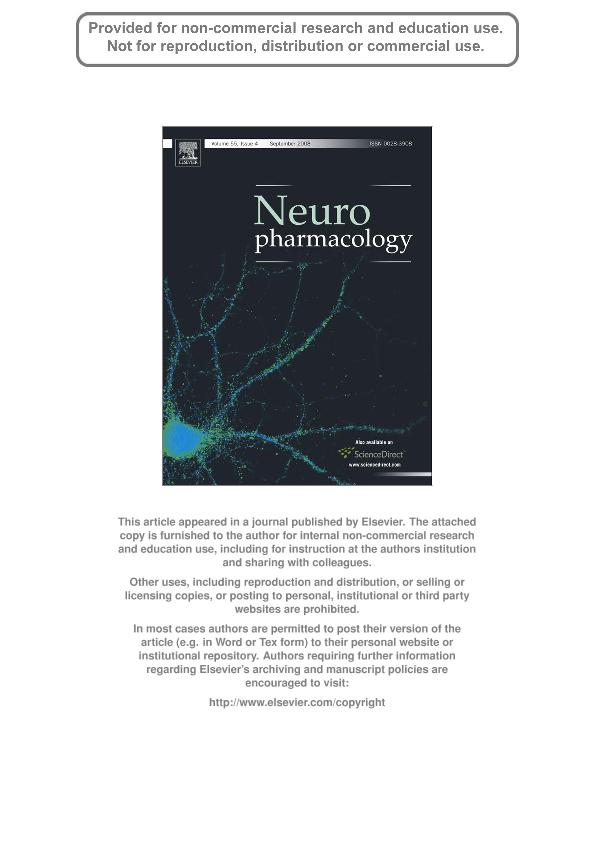Mostrar el registro sencillo del ítem
dc.contributor.author
Durand, Daniela Elizabeth

dc.contributor.author
Pampillo, Macarena
dc.contributor.author
Caruso, Carla Mariana

dc.contributor.author
Lasaga, Mercedes Isabel

dc.date.available
2020-08-14T15:45:32Z
dc.date.issued
2008-12
dc.identifier.citation
Durand, Daniela Elizabeth; Pampillo, Macarena; Caruso, Carla Mariana; Lasaga, Mercedes Isabel; Role of metabotropic glutamate receptors in the control of neuroendocrine function.; Pergamon-Elsevier Science Ltd; Neuropharmacology; 55; 4; 12-2008; 577-583
dc.identifier.issn
0028-3908
dc.identifier.uri
http://hdl.handle.net/11336/111767
dc.description.abstract
Glutamate exerts its effects through binding and activation of two classes of specific receptors: ionotropic (iGluRs) and metabotropic (mGluRs). Group I mGluR includes mGluR1 and mGluR5 subtypes, group II includes mGluR2 and mGluR3 subtypes and group III includes the subtypes mGluR 4, 6, 7 and 8. Glutamate and its receptors are found in all key hypothalamic areas critically involved in reproduction and neuroendocrine function. To date, considerable data support an important role for iGluRs in the control of neuroendocrine function; however, the role of mGluRs as regulators of hypothalamic-pituitary function has not been clearly elucidated. mGluRs could be exerting a fine tune on the release of hypothalamic factors that regulate hormone release such as Substance P, GABA, alpha-MSH and CRH. Group II mGluR exert a direct inhibitory effect on anterior pituitary prolactin and GH secretion. Moreover, some group II mGluR agonists, like LY 354,740 and LY 379,268, can modulate PRL secretion from the anterior pituitary through their actions as dopamine receptor agonists. Evidence suggests a role for group III mGluR subtypes in stress-related behavioral disorders. Several reports indicate that selective ligands for mGluR subtypes have potential for the treatment of a wide variety of neurological and psychiatric disorders, including depression, anxiety disorders, schizophrenia, epilepsy and Alzheimer´s disease among others. Since converging lines of evidence suggest a role for mGluRs subtypes in neuroendocrine regulation of hormone secretion, mGluRs neuroendocrine actions must be taken in consideration to insure proper treatment of these diseases. Moreover, discovery of selective agonists provides an opportunity to investigate the physiological role of mGluR subtypes and to directly test the neuroendocrine actions of mGluRs. Finally, mGluRs selective agonists may have an impact in the treatment of conditions involving chronic stress, such as depression and anxiety disorders, since they regulate neuroendocrine stress circuits involving the HPA axis and stress-sensitive hormones such as oxytocin and prolactin. This review aims to provide a survey of our current understanding of the effects of mGluR activation on neuroendocrine function.
dc.format
application/pdf
dc.language.iso
eng
dc.publisher
Pergamon-Elsevier Science Ltd

dc.rights
info:eu-repo/semantics/openAccess
dc.rights.uri
https://creativecommons.org/licenses/by-nc-sa/2.5/ar/
dc.subject
GLUTAMATE
dc.subject
MGLUR
dc.subject
NEUROENDOCRINE REGULATION
dc.subject.classification
Fisiología

dc.subject.classification
Medicina Básica

dc.subject.classification
CIENCIAS MÉDICAS Y DE LA SALUD

dc.title
Role of metabotropic glutamate receptors in the control of neuroendocrine function.
dc.type
info:eu-repo/semantics/article
dc.type
info:ar-repo/semantics/artículo
dc.type
info:eu-repo/semantics/publishedVersion
dc.date.updated
2020-05-11T15:49:04Z
dc.journal.volume
55
dc.journal.number
4
dc.journal.pagination
577-583
dc.journal.pais
Estados Unidos

dc.journal.ciudad
Amsterdam
dc.description.fil
Fil: Durand, Daniela Elizabeth. Consejo Nacional de Investigaciones Científicas y Técnicas. Oficina de Coordinación Administrativa Houssay. Instituto de Investigaciones Biomédicas. Universidad de Buenos Aires. Facultad de Medicina. Instituto de Investigaciones Biomédicas; Argentina
dc.description.fil
Fil: Pampillo, Macarena. Western University; Canadá
dc.description.fil
Fil: Caruso, Carla Mariana. Consejo Nacional de Investigaciones Científicas y Técnicas. Oficina de Coordinación Administrativa Houssay. Instituto de Investigaciones Biomédicas. Universidad de Buenos Aires. Facultad de Medicina. Instituto de Investigaciones Biomédicas; Argentina
dc.description.fil
Fil: Lasaga, Mercedes Isabel. Consejo Nacional de Investigaciones Científicas y Técnicas. Oficina de Coordinación Administrativa Houssay. Instituto de Investigaciones Biomédicas. Universidad de Buenos Aires. Facultad de Medicina. Instituto de Investigaciones Biomédicas; Argentina
dc.journal.title
Neuropharmacology

dc.relation.alternativeid
info:eu-repo/semantics/altIdentifier/url/https://www.sciencedirect.com/science/article/abs/pii/S0028390808002062
dc.relation.alternativeid
info:eu-repo/semantics/altIdentifier/doi/http://dx.doi.org/10.1016/j.neuropharm.2008.06.022
Archivos asociados
